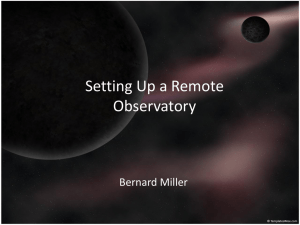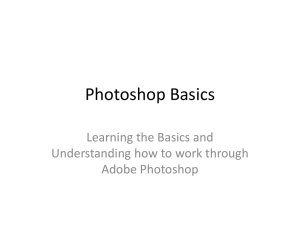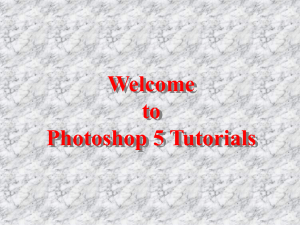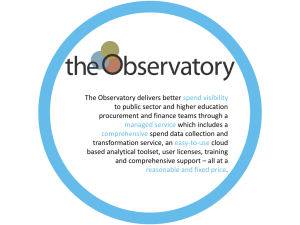Astrophotography - What am I Doing
advertisement
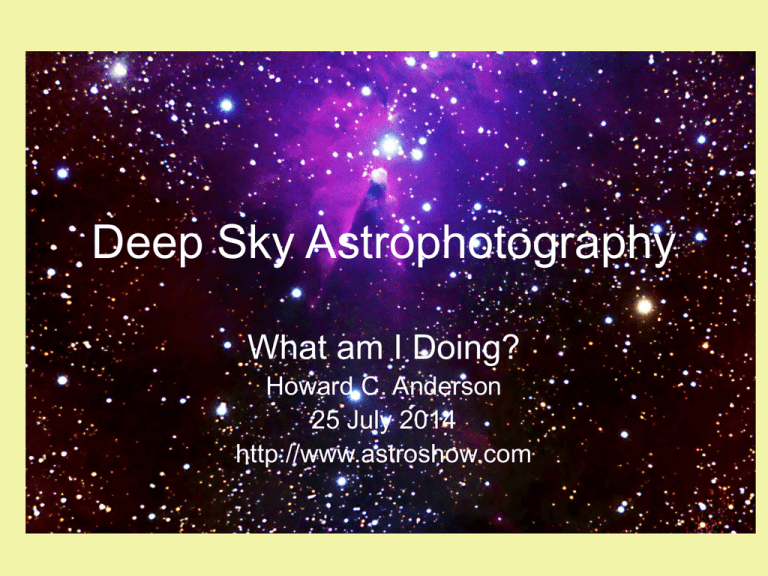
Deep Sky Astrophotography What am I Doing? Howard C. Anderson 25 July 2014 http://www.astroshow.com Overview • • • • • • • Location (Dark skies help) Observatory Hardware Software Figure out what to shoot Shoot images Process images Location • Dark sky helps a lot. Main reason for locating remotely… • My observatory is in New Mexico south of Lordsburg where we have really dark skies. • Bernard’s observatory is close by as are several others including Eric Africa’s both of whom take truly excellent images. • I didn’t know remote operation was possible until I saw Bernard Miller’s presentation at an EVAC meeting some time ago… I used his presentation as a guide: http://www.azstarman.net/remote_observatory_web.ppt • I’m still learning image processing – Maybe always will be… Rancho Hidalgo – ~250 Miles Observatories at Granite Gap Observatories at Rancho Hidalgo My Observatory at Rancho Hidalgo Hardware • Meade LX-200 10”, SBIG STL-11000 Camera, Astrodon filters for LRGB and Hydrogen Alpha, water cooling system for camera (CPU over-clock cooler), Optec TCFsi focuser. • Takahashi TOA-130 (5 inch) refractor, SBIG ST4000XCM single-shot color camera, Celestron CGE mount, Optec TCF-si focuser. • 32-bit PC computer running Windows 7 • Foster roof control board • 4 inside video cameras so I can see position of the roof and the scopes (… Just in case…) • Foster weather monitor (clouds, temperature, wind) Software • • • • • • • • • • • • • • • Remote Desktop (Free) (Operate remote computer) http://nova.astrometry.net (All-sky plate solver) TheSkyX Pro (Display sky, choose objects to shoot, get coordinates) VMware Workstation (Computer within a computer so to speak) Foster Dashboard (roof control) and AstroAlert (weather) Web Power Switch (Turn stuff on and off) NexRemote (Celestron CGE control software) ACP Observatory Control Software (Controls roof, scope, camera) Maxim DL imaging software (camera control, image processing...) FocusMax (Freeware) (Automatic focus system) CCDStack (Image processing. Best deconvolution algorithm) eXcalibrator (Freeware) (Color calibration using known star colors) Photoshop (Image processing – Essential, expensive, hard to use) Paint Shop Pro (Image processing software) Software I wrote: CheckPorts, ComputeFocus, FixBadPixels, etc. Web Power Switch CheckPorts Attention Span Relief Your secrets are safe in England Roof and Weather Check Cameras Inside Observatory Remote Desktop view of Virtual Machine ComputeFocus Optec Focuser TheSkyX Pro Mosaic ACP Script to automate mosaic imaging of Pelican Nebula Target • #waituntil 0, 02:30:00; UTC == 7:30 PM • #domeopen • • #waituntil 0, 05:30:00; UTC == 10:30 PM #chill -10 • • #autofocus #AFINTERVAL 60 • ;Pelican Nebula mosaic region. • • • • • #sets 2 #count 1 #interval 1200 #binning 1 Pelicana 20.89081215 44.46455987 • • • • #count 1 #interval 1200 #binning 1 Pelicanb 20.81334255 44.46455645 • • • • #count 1 #interval 1200 #binning 1 Pelicanc 20.89027385 43.63525503 • • • • #count 1 #interval 1200 #binning 1 Pelicand 20.81388148 43.63525166 • #shutdown Run the Script in ACP • • • • • I start script running in ACP Script waits until time I say it should start doing things Opens roof (allows things to cool down - summertime) Waits again until specified time to begin imaging Sets camera temperature and waits until camera temperature is what I specified • FocusMax then finds a suitable star, moves scope, and focuses camera • I told it to refocus every hour. It does that automatically between shots Run the Script in ACP • After focus, ACP moves scope back to designated object • ACP takes 30 a second image, plate-solves, moves scope dead-on • ACP then runs auto-guider subsystem and starts autoguiding • If guiding is OK, ACP starts taking an image using the exposure time I specified (1200 seconds in this case, i.e., 20 minutes) • ACP will take all the images I specified, refocus periodically between images, and store the images in a default location • I will be sleeping during this… I am a “morningperson…” ACP Image Folder for Pelican Target (Single-Shot Color Camera) Attention Span Relief Victor Borge Single-shot color cameras Bayer Mask You initially have a gray image that needs to be CONVERTED to RED, GREEN and BLUE gray images which are then combined to give a full color image… (Green light contributes roughly twice as much to our perception of brightness than does the combined effect of red and blue.) My Video Monitor Red, Green and Blue Images Combine RGB images to get color image Small star on monitor - magnified… Example: IC4865 - FixBadPixels (i.e., color convert, calibrate) Then Stack – Image Excerpts Single Original Single Original Fixed 10 Fixed, Stacked 300X Excerpts to Show Improvements Single Original Single Original Fixed 10 Fixed, Stacked Transfer Stacked Image from Observatory computer to local computer and start image processing • In Maxim DL, “Convert to Mono” to create Luminance (L) image • Use CCDStack to deconvolve the L image • Deconvolution is a process that undoes the "blurring" obtained after convoluting data. See http://en.wikipedia.org/wiki/Convolution • Save the deconvolved image as the new L image Correct color using eXcalibrator • In Maxim DL “Split Tricolor” to create Red, Green and Blue images (If I start from a full-color image) • Do “Pinpoint Astrometry” (plate solve) Red image and save it (Creates World Coordinate System (WCS) data) • Use R, G, and B images in eXcalibrator. Use R image as WCS image • Use NOMAD database • “Calibrate Image” • “Remove Outliers” • Get correction values for R, G and B images eXcalibrator Color Correction Coefficients Combine LRGB with Color Correction • In Maxim DL, combine LRGB images using the correction values • Save image as a 16-bit TIFF image for use with PhotoShop Attention Span Relief Remote Control Roundup Photoshop Processing • Read in 16-bit TIFF image • Looks pretty dark • Use “Curves” successively to brighten (as recommended in “Photoshop Astronomy”) PhotoShop “Curves” Successive Curves Levels Adjust • Use Levels to adjust dark level Photoshop Add-on: Astronomy Tools V1.6 • I apply “Make Stars Smaller” 3 times usually. • I apply “Space Noise Reduction” and “Deep Space Noise Reduction as needed to reduce graininess of the image. • I apply “Increase Star Color” until I am happy with star colors. • Then additional tweaking of Curves and Levels in PhotoShop until I am happy with amount of detail visible. Additional PhotoShop Operations • Vibrance: • If I err, it is on the side of too colorful I guess… I like color… Vibrance Result Tweak Curves, Levels, Vibrance, etc., in PhotoShop then save as JPG Paint Shop Pro Final tweak of brightness, contrast, etc., resulting in this: http://www.lightfigures.com/DSS2 Pelican Mosaic (4 images) M51 – Whirlpool Galaxy Cone Nebula Flame Nebula and Horsehead Nebula M109 and Flashlight of God Finis • See my images at: http://www.astroshow.com • Questions?



